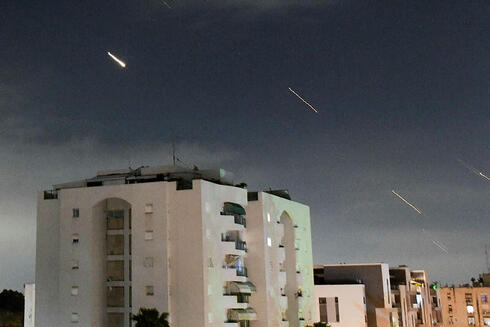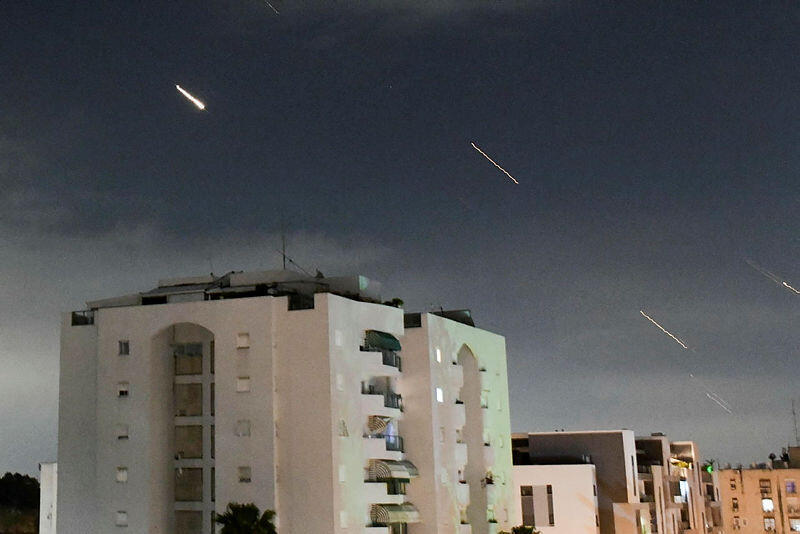
99% interception success rate: Behind Israel’s multi-layered air defense system that thwarted Iran
Iran launched over 300 aerial threats, including ballistic missiles, cruise missiles, and drones. Israel intercepted the vast majority of them. The operation, which lasted several hours, is estimated to have cost over a billion dollars
Israel's air defense systems intercepted over 100 ballistic missiles from Iran overnight and Israeli aircraft and other airborne combat teams intercepted around 100 drones launched towards Israeli territory from various regions in Iran, Iraq, and Yemen. This is the first time in world military history that a barrage of 100 ballistic missiles has been launched against a single country.
Israel's defense systems managed to intercept most of the missiles – Israeli Air Force pilots, operating in close cooperation and coordination with American, British, and Jordanian pilots, also intercepted most of the drones in the skies over remote deserts. The Israeli Air Force is equipped with approximately 450 aircraft, most of which are the world's most advanced fighter jets made in the United States, including the F-35 stealth aircraft, and F-15 and F-16 aircraft.
Iran launched over 300 airborne threats, including ballistic missiles, cruise missiles, and drones. Around 99% of the threats launched at the Israeli state were intercepted. According to reports, none of the 170 drones managed to penetrate Israeli territory. Out of more than 30 cruise missiles, none managed to penetrate the defense layers.
In addition, over 120 ballistic missiles were launched towards Israeli territory, but only a few managed to penetrate and fell on an Air Force base in the south of the country. Iran had hoped to damage Israel's air capabilities, but Air Force aircraft continued to take off and land from the base. There were also some launches from Iraq and Yemen. None penetrated Israeli territory.
The Israeli air defense system operated at least three layers of defense for different ranges: Iron Dome, David's Sling, and the Arrow system - each covering larger radii of aerial threats. According to the multi-layered defense concept, defense systems complement each other to maximize interception chances. For example, if Arrow 3 misses a ballistic missile outside the atmosphere, there's still enough time for Arrow 2 to attempt interception within the atmosphere.
In an interview with the Ynet website, Brigadier General (Res.) Reem Aminoach, former financial advisor to the Chief of Staff, estimated that the cost of the aerial defense operation against the Iranian attack amounted to more than a billion dollars. "If we're talking about ballistic missiles that need to be intercepted with the Arrow system, cruise missiles that need to be intercepted with other missiles, and drones, which we mainly intercept with aircraft - then you add up the costs - $3.5 million per Arrow missile, a million dollars per David's Sling interceptor, and costs like these for aircraft. This all adds up to a magnitude of $5-4 billion shekels," Aminoach said.
The air defense system is supposed to protect Israel from all types of threats – from a ballistic missile launched from Iran or Yemen to Israel, a distance of over 1,000 km, to a rocket fired from the Gaza Strip to Sderot, a distance of 2-3 km. Israel's air defense posture, which has evolved and solidified over the years, is multi-layered and incorporates a variety of systems tailored to different threats, differing in their flight speed, flight time and pattern, size, and mass.
The first layer of defense is the Iron Dome batteries – a system developed by Rafael, capable of defending an area of up to 150 square kilometers per battery. It features various types of sensors, with its centerpiece being the radar. The radar is capable of detecting and tracking ballistic missiles, rocket launches, missiles, bombs, and mortar shells, determining the type of projectile fired, calculating its trajectory, and guiding intercepting missiles towards it.
Iron Dome batteries are deployed throughout Israel from north to south and manned by Air Defense Corps soldiers, with the national control and command center behind them. The cost of a single interception by the Iron Dome system is $30,000, and the system can intercept short-range rockets, drones, and mortar shells. Iron Dome can intercept targets within a range of up to 40 kilometers, and there is a version used by the Navy, deployed on ships, called "C-Dome."
The next layer of defense is the David's Sling system, also known as the "Magic Wand," which, like Iron Dome, was developed by Rafael. Its role is to defend large areas, almost at a national level, and it is capable of intercepting medium and long-range rockets, cruise missiles, and precise heavy rockets. The David's Sling system consists of warning sensors, launchers, and a remote control unit. The two-stage interceptor can reach speeds of about 9,000 km/h, faster than any target missile. The estimated cost of a single interception by the system is $700,000, and it is capable of intercepting targets within a range of between 40 to 300 kilometers.
Covering the longest range is the Arrow system, actually composed of two systems – Arrow 2 and Arrow 3 – developed by Israel Aerospace Industries' MLM Division (Missile Systems & Space). The Arrow is intended to intercept intercontinental ballistic missiles by launching two interceptors simultaneously towards the target.
The Arrow 3 system comprises highly capable radars, and its operational principle is based on direct impact with the target missile and its destruction through kinetic energy without the need for explosive materials, unlike Arrow 2, which destroys the target missile with a warhead. The Arrow system can intercept ballistic missiles with nuclear warheads outside the atmosphere, with a single interception cost estimated at $1.5 million. Its interception range is between 300km to 2,000km.
Additionally, in the closest and most immediate layer, laser-based systems are supposed to be employed to intercept the smallest threats, including short-range rockets, mortars, drones, and even airborne gliders and kamikaze drones, alongside electronic jamming systems to neutralize the control of such threats. "Magen Or" (Iron Beam) is the next step up in Israel's self-defense: a laser system that can "cook" rockets, missiles or drones from afar, and at zero cost compared to the Iron Dome. It will be able to intercept rockets from Gaza even before they cross the border while Israeli citizens sleep soundly with no need to sound alarms.
The Patriot system is also still in use, serving as a backup to some of the mentioned systems, alongside specific capabilities for intercepting aircraft.














